 PROFECTIO, the departure of a Roman emperor going off to war
PROFECTIO, the departure of a Roman emperor going off to war PROFECTIO, the departure of a Roman emperor going off to war
PROFECTIO, the departure of a Roman emperor going off to war
Arrivals are relatively common on Roman coins. Departures are uncommon. When the emperor had been residing in Rome and decided to go off to war, the occasion was important. Sometimes it was recorded on coins with a "PROFECTIO" type. In Latin, "Profectio" means "departure." (Other travel types are discussed below.)
What's new? March 30, 2018: NEPTVNO REDVCI
This page illustrates and discusses PROFECTIO types for
1) Severus Alexander (the coin to the right), and
2) Septimius Severus (below), and
3) Caracalla (Two types: horseman, emperor and attendant),
and gives
4) a list of emperors who issued PROFECTIO types, and
This page also comments on other travel types including ADVENTVS (arrival) types.
Severus Alexander, emperor AD 222-235, departing in 231 for a Persian war.
Sestertius. 30 mm. 21.68 g. Lovely green patina.
IMP SEVERVS ALEXANDER AVG
PROFECTIO AVGVS-TI
Emperor with spear on horseback right, led by Victory bearing wreath. SC below. RIC 596. Sear II 8012.
The symbolism of the reverse is clear. You are going off to war, led by Victory.
In 227 the Parthians were overthrown by Ardeshir, the first Sasanian King. In 230 he invaded Roman territory across the Euphrates river. Attempts to negotiate peace failed and Rome went to war (see this type). In 232 some Roman territory was regained and although not decisive, a victory could be claimed. It coincided with his tenth anniversary, so coins were issued with "VICTORIA AVGVSTI, Victory inscribing VOT X on a shield" [not illustrated here]. There are other types are associated with the victory, but not explicitly. Here is one:
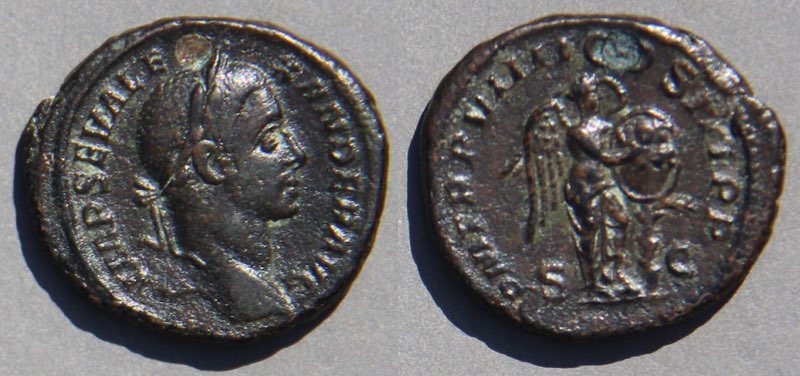 Severus Alexander (222-235). As. 26-24 mm. (Holed and plugged at 12:00.)
Severus Alexander (222-235). As. 26-24 mm. (Holed and plugged at 12:00.)
IMP SEV ALEXANDER AVG
PM TRP VIIII COS III PP S C
RIC 506. Sear II 8083.
Victory inscribing VOT X on a shield supported by a palm-tree column.
The association with the victory in the East is likely, but not certain. Severus Alexander used victory on some of his very first issues, long before he had any actual victory. However, the column on which the shield rests is not a stone column, rather a palm-tree column usually associated with victories in the East and VOT X is the right time.
 Septimius Severus. Emperor 193-211. Septimius Severus departs the East for Rome (which is the reverse of the usual direction for PROFECTIO types).
Septimius Severus. Emperor 193-211. Septimius Severus departs the East for Rome (which is the reverse of the usual direction for PROFECTIO types).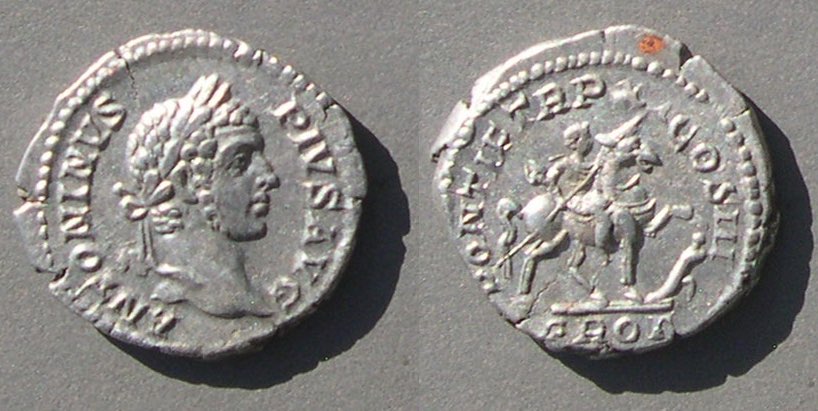 Caracalla. Emperor 198-217. Caracalla departed for the British campaign in 208.
Caracalla. Emperor 198-217. Caracalla departed for the British campaign in 208.
Caracalla. Denarius. 20-18 mm.
ANTONINVS PIVS AVG (We call him Caracalla; his name on coins was Antoninus Pius. "Caracalla" is a nickname taken from the long Gallic cloak he wore and made fashionable.)
PROF (for PROFECTIO) below horseman right with a captive before
(If you go off to war, you intend to return with captives.)
PONTIF TRP XI COS III. TRP XI dates the coin to 208.
RIC 108 "Scarce, AD 208". Sear II 6874.
A similar horseman right with "PROF" below (and a different legend around) was also issued for Severus.
His father and he claimed victory in the war in Britain and issued "VICTORIA BRIT" coins of several varieties. One is next.
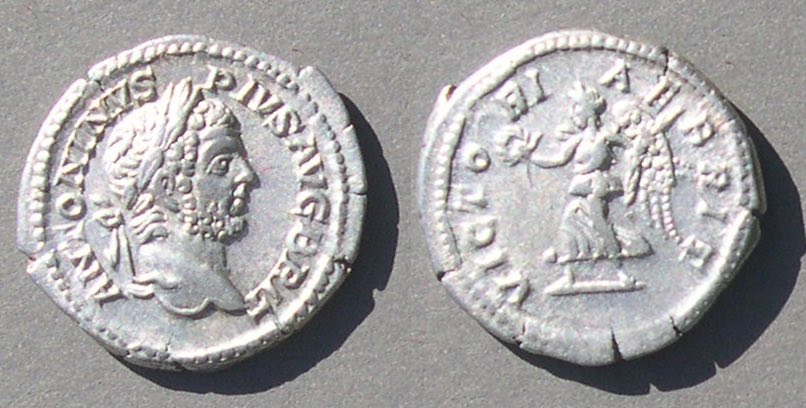 Caracalla. Denarius. 19 mm.
Caracalla. Denarius. 19 mm.This same type was also issued for Severus.
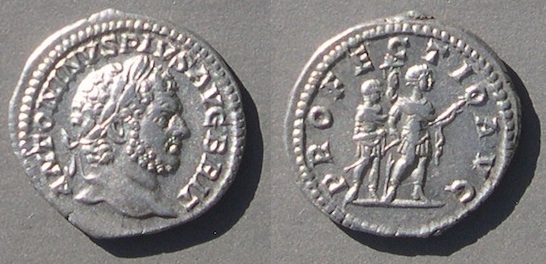 German Campaign. Caracalla's father, Septimius Severus, died while in Britain in 211. Caracalla immediately returned to Rome. In 213 he departed Rome to campaign in Germany. "At that time the loose confederation of tribes known as the Alamanni are first mentioned as enemies of Rome." [Grant, p. 118]
German Campaign. Caracalla's father, Septimius Severus, died while in Britain in 211. Caracalla immediately returned to Rome. In 213 he departed Rome to campaign in Germany. "At that time the loose confederation of tribes known as the Alamanni are first mentioned as enemies of Rome." [Grant, p. 118]
Caracalla. Denarius. 19 mm.
ANTONINVS PIVS AVG BRIT (BRIT for victories in Britain)
PROFECTIO, Caracalla standing right with transverse spear, standard-bearer behind.
RIC 226 "Scarce, 210-213". Hill 1337 "S2, 213." ("S2" means 20-30 in the hoards he knew about).
Later that year Caracalla issued gold aurei with "VICTORIA GERMANICA" but none of the silver or AE types mention it prominently on the reverse (there is nothing with "GERM" on the reverse). However, late in 213 he replaced "BRIT" with "GERM" in the obverse title, claiming victory over the Germans. An example is next.
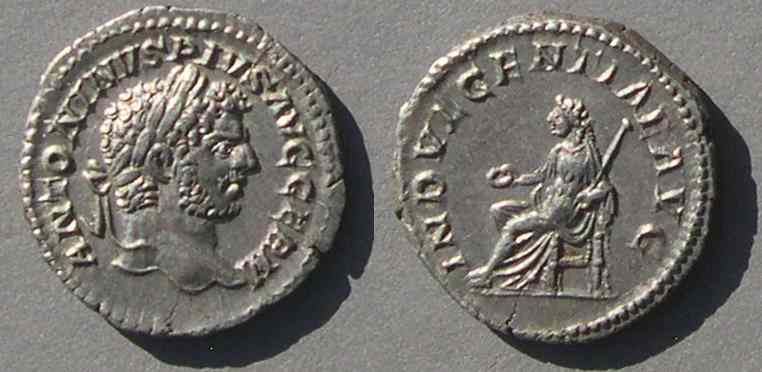 Caracalla. Denarius. 19 mm.
Caracalla. Denarius. 19 mm."Indulgentia" refers to a special favor. In this case it may refer to "the most famous legal measure of antiquity, the Constitutio Antoniniana, promulgated by Caracalla in 212 and named after him. With the exception of slaves, this enactment bestowed upon virtually the entire population of the Empire the status of Roman citizens, which had hitherto been restricted to Italians and a relatively small elite body of provincials." [Grant, p. 119]
The type is very scarce. I think the new law was not popular with the current citizens and the type was rapidly discontinued.
Emperors who issued PROFECTIO types [according to Foss]:
Trajan, in 113, departing for the Parthian war
Marcus Aurelius, in 169, departing for German wars
Lucius Verus, in 162, departing for the eastern front
Commodus as Augustus with Aurelius, in 178, departing for the northern front
Septimius Severus, in 196/7, departing for the campaign against Clodius Albinus
in 197, departing for the Parthian campaign
in 200, departing the East for Rome (not the usual direction) (illustrated above)
in 208, departure for the British front
Caracalla, in 208, departing for the British front (illustrated above)
in 213, departing for campaigns in Germany (illustrated above)
Severus Alexander, departing for a Persian war (illustrated above)
Postumus, in 260, departing for a campaign against the Germans
Licinius, in 313, departing to meet the attack of Maximinus (only on gold)
Other travel types. Emperors traveled frequently. Other types emphasize trips in other ways. They include
1) ADVENTVS types for arrivals (Here is a page on ADVENTVS types)
2) naming the region visited, as with Hadrian's famous "travel series"
3) focusing on prayers for a safe return, FORTVNA REDUX,
4) a ship (galley) for sea travel
5) other, for example scenes of welcome
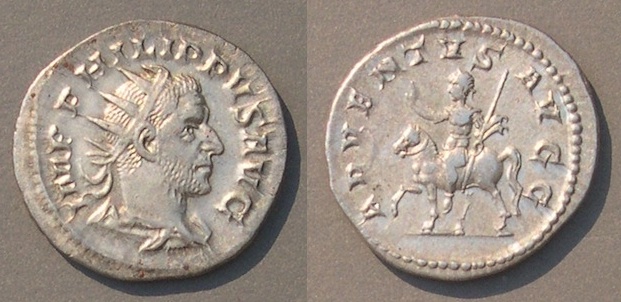 ADVENTUS. ADVENTVS types are common. Here is one issued for Philip I (244-249) recording his arrival to Rome.
ADVENTUS. ADVENTVS types are common. Here is one issued for Philip I (244-249) recording his arrival to Rome.
Philip I, AD 244-249. 22 mm.
IMP PHILIPPVS AVG
ADVENTVS AVGG, Philip riding left, raising right in greeting and holding long scepter in left.
RIC 26b "245". Sear II 2916. Foss Philip 6 for an event of 244, Philip's arrival in Rome.
(See here for a page on ADVENTVS types.)
 Regions Visited. Hadrian (117-138) is famous for traveling during much of his reign.
Regions Visited. Hadrian (117-138) is famous for traveling during much of his reign.
Hadrian, 117-138. Denarius. 18 mm.
HADRIANVS AVG COS III PP
RESTITVTORI GALLIAE, togate emperor raising kneeling Gallia (Gaul, the region).
RIC 324d "134-138". Sear II 3534.
Hadrian's famous "travel series" apparently was issued near the end of his reign after his travels were over.
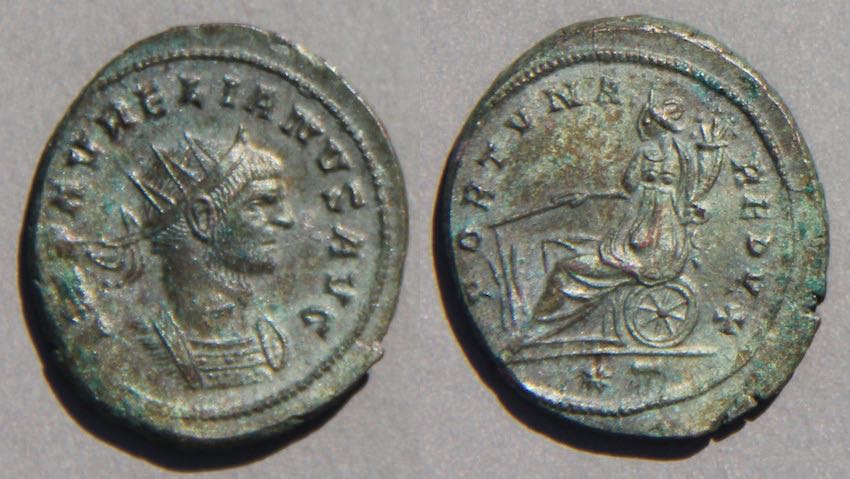
FORTVNA REDVX. Fortuna Redux was invoked for a safe return from a trip. Here is one for Aurelian (270-275).
IMP AVRELIANVS AVG
FORTVNA REDVX, Fortune seated left on a wheel (the wheel of Fortune), holding a rudder and coruncipia.
Travel was dangerous. Travelers would pray for a safe return, and Fortuna was the appropriate goddess.
(I have a web page on the use of this type under the tetrarchy.)
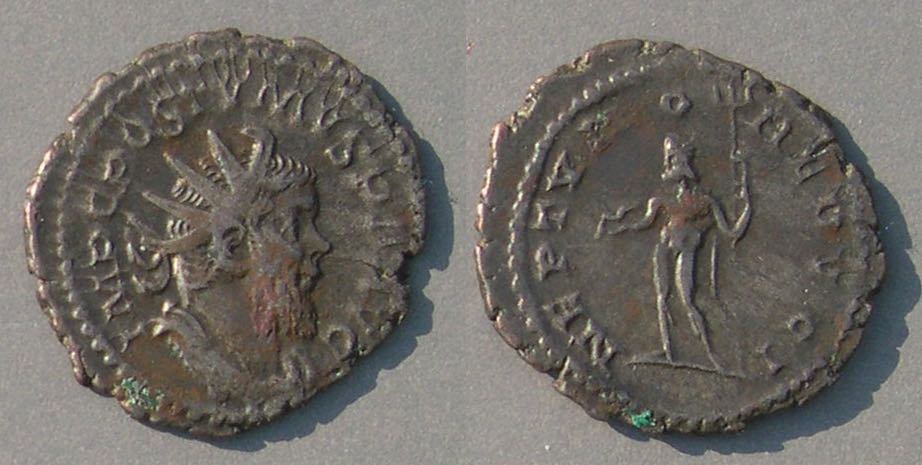 Neptuno Reduci. Travel on water required the cooperation of Neptune for a safe return.
Neptuno Reduci. Travel on water required the cooperation of Neptune for a safe return.
Postumus, 259-268.
24-22 mm.
IMP POSTVMVS PF AVG
NEPTUNO REDVCI, Neptune standing holding (small) dolphin and trident.
Sear III 10963. RIC 76, Lugdunum.
Hadrian. Denarius. 19 mm.
IMP CAES TRAIAN HADRIANVS AVG
PM TRP COS III, a galley left with small sail.
RIC 113b "119-122". Hill 215. Foss 35 for an event of 121. "Departure of Hadrian on his travels ... with the ship indicating a long voyage."
 Other travel types. Welcome to Egypt.
Other travel types. Welcome to Egypt.
Caracalla (196-198-217). Sestertius. 31 mm.
Struck 215 for his imperial visit to Alexandria.
Caracalla standing left in military dress, right foot on crocodile, holding reversed spear. Isis advancing right to him, holding out ears of grain in her right hand and holding a sistrum in her left hand.
PM TRP XVIII IMP II COS IIII PP, which gives the date as TRP XVIII.
RIC 544. Sear II 6938.
On CoinTalk Blake Davis noted the irony. I thank him for this note.
Cassius Dio reports that,
"Now Antoninus, in spite of the immense affection which he professed to cherish for Alexander, all but utterly destroyed the whole population of Alexander's city. For, hearing that he was ill-spoken of and ridiculed by them for various reasons, not the least of which was the murder of his brother, he set out for Alexandria, concealing his wrath and pretending that he longed to see them. So when he reached the suburbs, whither the leading citizens had come with certain mystic and sacred symbols, he first greeted them cordially, even making him his guests at a banquet, and then put them to death. Then, having arrayed his whole army, he marched into the city, after first notifying all the inhabitants to remain at home and after occupying all the streets and all the roofs as well. And, to pass over the details of the calamities that then befell the wretched city, he slaughtered so many persons that he did not even venture to say anything about their number, but wrote to the senate that it was of no interest how many of them or who had died, since all had deserved to suffer this fate. Of the money in the city, part was plundered and part destroyed. Together with the citizens there perished also many outsiders, and not a few of those who had accompanied Antoninus were slain with the rest through ignorance of their identity; for, as the city was large and people were being murdered in all parts of it simultaneously both by night and by day, it was impossible to distinguish anybody, however much one might desire to do so, but people perished as chance directed and their bodies were straightway cast into deep trenches, to keep the rest from becoming aware of the extent of the calamity. Such was the fate of the natives." [From Cary translation in Loeb, in the public domain, Book 78.]
 Elagabalus (218-222). Transport of the sacred stone of Emesa to Rome.
Elagabalus (218-222). Transport of the sacred stone of Emesa to Rome.Denarius. 17 mm. Struck 218-219.
ANTONINVS PIVS FEL AVG (the name Elagabalus used on coins was "Antoninus Pius")
SANCT DEO SOLI, triumphal cart drawn by four horses right, carrying the conical stone of Emesa, on which sits an eagle, with four parasols about it. ELAGABAL in exergue.
RIC 195d. Sear II 7545.
Elagabalus transported his god, the sacred stone of Emesa, to Rome from Syria. The ancient historian Herodian wrote that he walked front of the cart facing backward toward his god, Elagabalus (which is the nickname we use for him), on its journey to Rome.
References.
Roman Imperial Coinage (RIC), various volumes.
Foss, Clive. Roman Historical Coins. 1990. Hardcover. 335 pages. [A list of all events mentioned on Roman imperial coins and short descriptions of the coins that mention them. Some commentary.]
Grant, Michael. The Roman Emperors. 1985. Hardcover. 367 pages. [Biographies of the emperors. Grant was an ancient historian (who published many books on Rome) and a numismatist (one time President of the Royal Numismatic Society) and his biographies emphasize events that made it onto coins. One coin obverse is illustrated for each of the emperors. I recommend this book which is now very inexpensive-- $1.99 plus shipping on Amazon.]
Hill, Philip V. The Coinage of Septimius Severus and His Family, AD 193-217. Second edition. 1977. Paperback. 42 pages and two plates (26 coins). This is an attempt to assign every type to a specific year. Some scholars disagree with some of his dates.
Go to the page of ADVENTVS types.
Go to the main Table of Contents page of this site.